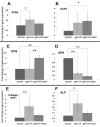Reprogramming of mouse fibroblasts into neural lineage cells using biomaterials
- PMID: 29977834
- PMCID: PMC6026523
- DOI: 10.15171/bi.2018.15
Reprogramming of mouse fibroblasts into neural lineage cells using biomaterials
Abstract
Introduction: Induced neural stem cells (iNSCs) have the ability of differentiation into neurons, astrocytes and oligodendrocytes. iNSCs are very useful in terms of research and treatment. The present study offers an idea that biomaterials could be one of the tools that could modulate reprogramming process in the fibroblasts. Methods: Gelatin biomaterials were fabricated into 3 types, including (i) gelatin, (ii) gelatin with 1 mg/mL hydroxyapatite, and (iii) gelatin with hydroxyapatite and pig brain. NIH/3T3 fibroblasts were cultured on each type of biomaterial for 7, 9 and 14 days. RT-PCR was performed to investigate the gene expression of the fibroblasts on biomaterials compared to the fibroblasts on tissue culture plates. PI3K/Akt signaling was performed by flow cytometry after 24 hours seeding on the biomaterials. The biomaterials were also tested with the human APCs and PDL cells. Results: The fibroblasts exhibited changes in the expression of the reprogramming factor; Klf4 and the neural transcription factors; NFIa, NFIb and Ptbp1 after 9 days culture. The cultivation of fibroblasts on the biomaterials for 7 days showed a higher expression of the transcription factor SOX9. The expression of epigenetic genes; Kat2a and HDAC3 were changed upon the cultivation on the biomaterials for 9 days. The fibroblasts cultured on the biomaterials showed an activation of PI3K/Akt signaling. The human APCs and human PDL cells developed mineralization process on biomaterials Conclusion: Changes in the expression of Klf4, NFIa, NFIb, Ptbp1 and SOX9 indicated that fibroblasts were differentiated into an astrocytic lineage. It is possible that the well-designed biomaterials could work as powerful tools in the reprogramming process of fibroblasts into iNSCs.
Keywords: Cell reprogramming; Fibroblasts; Induced neuronal stem cells.
Figures
Similar articles
-
SOX2 and SOX2-MYC Reprogramming Process of Fibroblasts to the Neural Stem Cells Compromised by Senescence.PLoS One. 2015 Nov 4;10(11):e0141688. doi: 10.1371/journal.pone.0141688. eCollection 2015. PLoS One. 2015. PMID: 26535892 Free PMC article.
-
Direct Cell Reprogramming of Mouse Fibroblasts into Functional Astrocytes Using Lentiviral Overexpression of the Transcription Factors NFIA, NFIB, and SOX9.Methods Mol Biol. 2021;2352:31-43. doi: 10.1007/978-1-0716-1601-7_3. Methods Mol Biol. 2021. PMID: 34324178
-
Direct reprogramming of fibroblasts into neural stem cells by defined factors.Cell Stem Cell. 2012 Apr 6;10(4):465-72. doi: 10.1016/j.stem.2012.02.021. Epub 2012 Mar 22. Cell Stem Cell. 2012. PMID: 22445517
-
Induced neural stem cells: methods of reprogramming and potential therapeutic applications.Prog Neurobiol. 2014 Mar;114:15-24. doi: 10.1016/j.pneurobio.2013.11.001. Epub 2013 Nov 15. Prog Neurobiol. 2014. PMID: 24246715 Review.
-
Potential application of induced pluripotent stem cells in cell replacement therapy for Parkinson's disease.CNS Neurol Disord Drug Targets. 2011 Jun;10(4):449-58. doi: 10.2174/187152711795563994. CNS Neurol Disord Drug Targets. 2011. PMID: 21495962 Review.
Cited by
-
Peak density of immature nerve cells occurs with high-grade dysplasia in intraductal papillary mucinous neoplasms of the pancreas.J Pathol. 2022 Sep;258(1):69-82. doi: 10.1002/path.5978. Epub 2022 Jul 18. J Pathol. 2022. PMID: 35686747 Free PMC article.
References
LinkOut - more resources
Full Text Sources
Other Literature Sources
Research Materials
Miscellaneous











